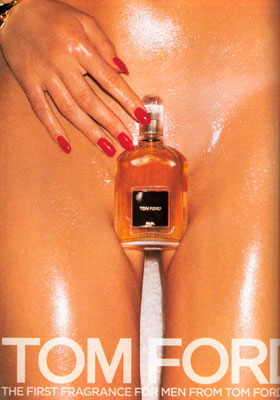“Wow, what the hell???” That’s what I said when I first saw the above ad for Dolce & Gabbana a year ago. It was immediately apparent to me that there was something very wrong with this ad, a thought not lost on others who saw it as well. Now, there is a lot that could be said to be wrong with this ad, but the worst thing that just jumps out of the ad (to me) is the glamorization of the implied gang rape, and by extension, the objectification of the woman in the ad. This ad tries to take a disgusting, violent, and dehumanizing act like rape and turn it into something sexy… just to sell us some clothes? While this is a problem, the real problem is actually much deeper than that. It isn’t that Dolce & Gabbana advertisers are trying to get you to buy their products by enticing you with (questionable) things like “sexy rape,” but instead the message that is given to us behind the ad that they have presented. At the very least, in an attempt to make the ad “edgy” and “sexy” to sell products, the advertisers have diminished the severity of rape to something harmless, something to be considered a “fantasy” or sexual game. And at the very worst, they have sent a message to the viewers of this ad that this kind of sexual violence is okay. In Killing Us Softly, Jean Kilbourne tells us that, “Advertising does sell products, of course, but it also sells a great deal more than products. It sells values, it sells images, it sells concepts of love and sexuality, of romance, of success, and perhaps most important, of normalcy. To a great extent, advertising tells us who we are and who we should be.” I think Kilbourne is absolutely right. But if that’s the case, then there is a huge problem with the values, images, and concepts that advertisements like the one above (and others) are selling to us.
Following up on the idea that advertisements sell more than just products, Jean Kilbourne also states that, as a result of these messages that advertisements send us, women in particular are constantly analyzed for flaws, and that “men basically don’t live in a world in which their bodies are routinely scrutinized, criticized, and judged.” In this statement, Kilbourne has given us the other side of the picture of advertisement, the actual influence that advertisements can have on us as a society, which is a crucial part of looking at and understanding these advertisements. However, I feel that the negative effects of the images sold by advertisements are not limited solely to women. Men, for example, are often given unrealistic or downright strange images of what it means to be a man, or have their manhood criticized for not fitting a stereotypical image of a man by advertisements. They are told that buying products to improve their masculinity will do all kinds of things from making them successful to (most often) making women want to sleep with them. Additionally, ethnic minorities and LGBT people (both men and women) suffer from poor representations in advertisements, which often resort to including them only in the most stereotypical ways, if at all.
I chose these ads because of how particularly blunt and eye-catching they are. Ads like these would easily catch the attention of anyone, no matter where they were placed. The intentions of these advertisements are to attract men’s attention and their purpose is to sell the cologne being advertised. However, the way that these advertisements present the product also sends an implied message to its target audience (men). Because the cologne is placed directly over a woman’s vaginal area in the first ad, and in between her breasts in the second, the ads seem to suggest that buying the cologne will help a man get a woman in bed. Although the purpose of cologne is to smell nice for yourself or others, the way the ad is presented suggests that simply wearing cologne is enough to get women in bed, without regard to any other factor that plays a role in sex. In this sense, the woman becomes a thing or commodity for use both as a tool to sell products and as a sex object. This is problematic because it sends the message to men that women as a whole (regardless of individual personality, values, etc.) are just objects to be conquered using whatever means works, and whose only role or function is as a sexual object. Taken together, these messages mean paint a demeaning picture of women and portray them unrealistically to men. Now, it’s no doubt that these ads could have their intended effect and entice men into buying this cologne, and thus could be seen as effective advertisement because, as the old adage goes “sex sells.” However, I think that advertisements can still be eye-catching and thus just as effective or successful without having to objectify those involved in the ad.
An alternative to the Tom Ford ad. (Source)
It was really difficult to find a similar ad (i.e. a men’s cologne ad) that did not involve objectified men or women, but I found two potential alternatives to the Tom Ford ads given above. The first features P. Diddy (or Sean Combs or Puff Daddy) in a nice suit, simply posed looking at the camera, and standing next to the product, I am King cologne. This is eye-catching because of the suggested elegance or high-class of the cologne based on the way Combs is dressed and the name of the product. It is also effective because celebrity sponsorship of products makes products seem even more marketable or worth buying. The second one is not a perfect ad, but it does present an alternative to both the Tom Ford ads by not objectifying anyone in it, and also to the I am King ad by presenting a different view of masculinity. In this ad, an advertisement for Mustang cologne, a man wearing sunglasses and looking very rugged looks towards a Mustang car in a desert-like (read: rugged) area, with a Mustang horse reflected in his sunglasses. I think that both these ads are better because they focus more on the product. However, while I don't think ads like these are the perfect compromise (because I feel that ads could still be "sexy" or "enticing" without having to objectify), they are a great starting point to begin looking at how we can change advertisements for the future.



No comments:
Post a Comment